
Andrew I, his Russian name in full, Andrey Yuryevich Bogolyubsky, was Grand prince of Vladimir-Suzdal from 1157 until his death. Andrey accompanied Yuri I Vladimirovich, his father, on a conquest of Kiev, then led the devastation of the same city in 1169, and oversaw the elevation of Vladimir as the new capital of northeastern Rus'. He was canonized as a saint in the Russian Orthodox Church in 1702.
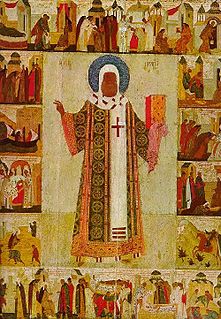
Peter, Metropolitan of Kyiv and all Rus (c. 1260- 20 December 1326) was the Russian metropolitan who moved his see from Vladimir to Moscow in 1325. Later he was proclaimed a patron saint of Moscow. In spite of the move, the office remained officially entitled "Metropolitan of Kiev and All Rus'" until the autocephalous election of Jonah of Moscow in 1448.
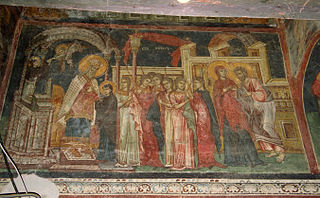
The Presentation of the Blessed Virgin Mary, known in the East as The Entry of the Most Holy Theotokos into the Temple, is a liturgical feast celebrated on November 21 by the Catholic, Eastern Orthodox, and some Anglo-Catholic Churches.

The Virgin of Vladimir, also known as Vladimir Mother of God, Our Lady of Vladimir, and the Theotokos of Vladimir, is a 12th-century Byzantine icon depicting the Virgin and Child and an early example of the Eleusa iconographic type. It is one of the most culturally significant and celebrated pieces of art in Russian history. Many consider it a national palladium with several miracles of historical importance to Russia being attributed to the icon. Following its near destruction in the thirteenth century, the work has been restored at least five times.

September 30 - Eastern Orthodox liturgical calendar - October 2

May 27 - Eastern Orthodox Church calendar - May 29

Marfo-Mariinsky Convent, or Martha and Mary Conventof Mercy in the Possession of Grand Duchess Elizabeth Feodorovna is a female convent in Moscow.

Our Lady of Kazan, also called Mother-of-God of Kazan, is a holy icon of the highest stature within the Russian Orthodox Church, representing the Virgin Mary as the protector and patroness of the city of Kazan, and a palladium of all of Russia and Rus', known as the Holy Protectress of Russia. As is the case for any holy entity under a Patriarchate in communion within the greater Eastern Orthodox Church, it is venerated by all Orthodox faithful.

August 14 - Eastern Orthodox liturgical calendar - August 16

The Intercession of the Theotokos, or the Protection of Our Most Holy Lady Theotokos and Ever-Virgin Mary, is a Christian feast of the Mother of God celebrated in the Eastern Orthodox and Byzantine Catholic Churches on October 1 . The feast celebrates the protection afforded the faithful through the intercessions of the Theotokos.

The Feodorovskaya Icon of the Mother of God, also known as Our Lady of Saint Theodore and the Black Virgin Mary of Russia, is the patron icon of the Romanov family. It is one of the most venerated icons in the Upper Volga region. Her feast days are March 14 (27) and August 29.

December 17 - Eastern Orthodox liturgical calendar - December 19
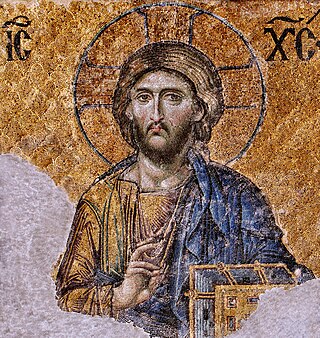
Eastern Orthodox worship in this article is distinguished from Eastern Orthodox prayer in that 'worship' refers to the activity of the Christian Church as a body offering up prayers to God while 'prayer' refers to the individual devotional traditions of the Orthodox.
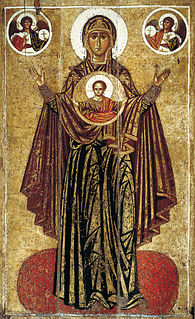
The Icon of Our Lady of the Sign is the term for a particular type of icon of the Theotokos, facing the viewer directly, depicted either full length or half, with her hands raised in the orans position, and with the image of the Child Jesus depicted within a round aureole upon her breast.
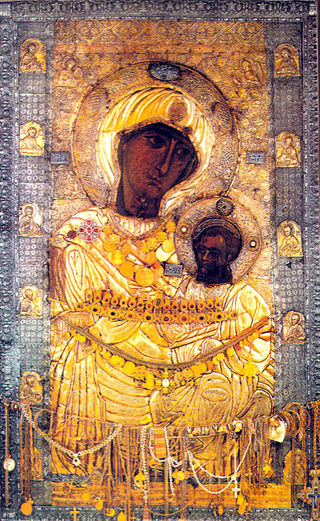
The Panagia Portaitissa also known as the Iviron Theotokos or Iverskaya in Russian, is an Eastern Orthodox icon of the Virgin Mary in the Georgian Iviron monastery on Mount Athos in Greece, where it is believed to have been since the year 999. According to the sacred tradition of the Eastern Orthodox Church it was painted by Luke the Evangelist. The icon is referred to as "Wonderworking" meaning that numerous miracles have been attributed to the intercession of the Theotokos by persons praying before it. The synaxis for this icon is on February 12, as well as on Bright Tuesday, and also on October 13 for the translation to Moscow of the Iveron icon.

Inexhaustible Chalice is a wonderworking icon of the Mother of God which revealed itself in Serpukhov, Russia in 1878. The icon is venerated in the Russian Orthodox Church and has become known for healing those who suffer from alcoholism, drug abuse and other forms of addiction.

Bogorodica Trojeručica or simply Trojeručica is a famous wonderworking icon in the Serbian Orthodox monastery of Hilandar on Mount Athos, Greece. It depicts Theotokos with young Jesus in the hodegetria position, and is covered with a riza. It is the most important icon of the Serbian Orthodox Church. On the back of the icon is the painting of St Nicholas.

The Cincture of the Theotokos is believed to be a relic of the Theotokos, now in the Vatopedi monastery on Mount Athos, which is venerated by the Holy Eastern Orthodox Church. The word "cincture" is sometimes also translated as "belt", "sash" or "girdle". It is the Orthodox equivalent of the Girdle of Thomas in the Western church, and the Syriac Holy Girdle. Its feast day is September 13.

December 25 – Eastern Orthodox liturgical calendar – December 27

Vladychny Monastery is a Russian Orthodox convent in Serpukhov, Moscow Oblast. It is located outside the downtown, near the confluence of the rivers Nara and Oka.















